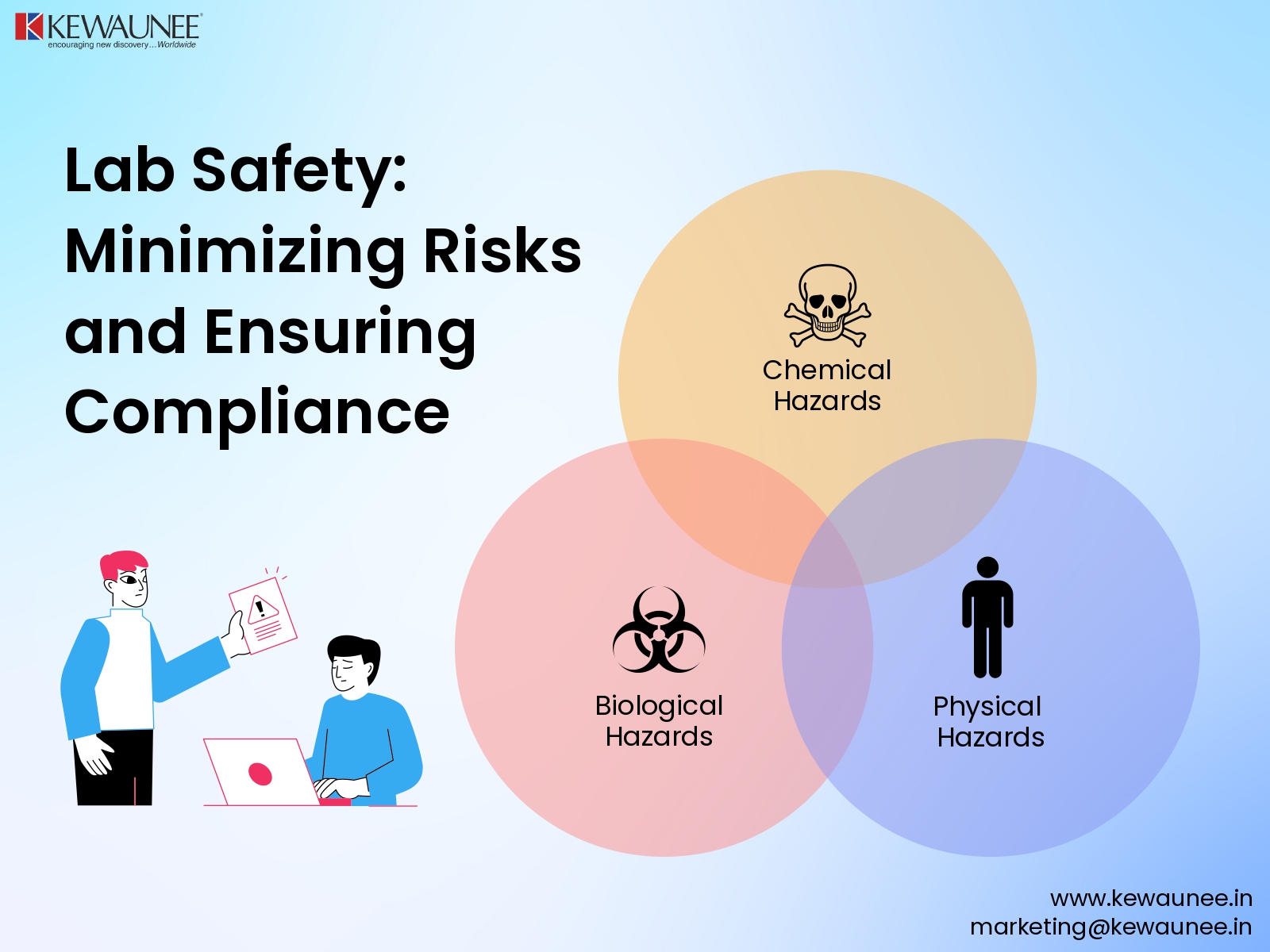Lab Safety: Minimizing Risks and Ensuring Compliance
In scientific research and laboratory settings, lab safety is of paramount importance. It not only protects the well-being of researchers and lab personnel but also safeguards the environment and public health. Understanding the potential risks and hazards involved in lab work is crucial for creating a safe and compliant working environment.
In this comprehensive guide, we will explore the various aspects of lab safety, from understanding laboratory hazards to implementing safety protocols and procedures, and ensuring regulatory compliance.
Understanding Laboratory Hazards
A. Chemical Hazards:
Chemicals are an integral part of laboratory work, but they can pose significant risks if mishandled. It is essential to be aware of the types of chemicals commonly found in labs and their associated risks. For instance, corrosive chemicals can cause severe skin burns, while toxic chemicals can have harmful effects on the respiratory system or other organs.
Proper handling, storage, and disposal of chemicals are crucial to minimize risks. Additionally, the use of personal protective equipment (PPE), such as gloves, lab coats, and safety goggles, is essential for chemical safety.
B. Biological Hazards:
Working with biological agents, including bacteria, viruses, and other microorganisms, requires adherence to specific safety measures. Biological hazards can lead to infections or diseases if proper precautions are not taken.
It is important to have a clear understanding of the potential risks associated with different biological agents and the appropriate biosafety levels and containment measures for handling them. Safe handling and disposal of biological materials, including proper waste management, are critical to prevent contamination and exposure.
C. Physical Hazards:
Physical hazards in the lab can lead to accidents and injuries if proper precautions are not taken. Common physical hazards include fire, electrical hazards, and radiation. It is important to implement safety measures to prevent accidents, such as maintaining clear pathways, keeping flammable materials away from ignition sources, and using appropriate shielding for radiation sources.
Emergency preparedness and response protocols, including evacuation procedures and emergency contacts, should be established and regularly reviewed to ensure everyone’s safety in case of an emergency.
Implementing Safety Protocols and Procedures
A. Risk Assessment and Hazard Identification:
Conducting thorough risk assessments is essential for identifying potential hazards and evaluating their severity. A comprehensive risk assessment involves analyzing the tasks performed, identifying potential hazards, and assessing the likelihood and potential consequences of those hazards.
By understanding the risks, appropriate control measures can be implemented to minimize or eliminate them. It is important to prioritize safety measures based on the identified risks, focusing on high-risk activities or hazards that can cause severe harm.
B. Standard Operating Procedures (SOPs):
Well-defined standard operating procedures (SOPs) are crucial for ensuring consistent safety practices in the lab. SOPs provide clear instructions on how to safely perform specific tasks, handle hazardous materials, use equipment, and respond to emergencies.
SOPs should be developed based on best practices, industry standards, and regulatory requirements. Regular review and updates of SOPs are necessary to incorporate new safety guidelines and reflect any changes in lab processes or equipment.
C. Training and Education:
Comprehensive safety training and continuous education are key to maintaining a safety-conscious culture in the lab. All lab personnel should receive proper training on safety protocols, including the handling of hazardous materials, proper use of PPE, emergency procedures, and the safe operation of equipment.
Training programs should be tailored to specific roles and tasks within the lab. It is important to provide refresher training and updates on new safety practices and regulations to ensure that all personnel are up-to-date with the latest safety guidelines.
Laboratory Infrastructure and Equipment
A. Safety Equipment and Engineering Controls:
Safety equipment, such as fume hoods, eyewash stations, and emergency showers, should be readily available and properly maintained. Fume hoods help contain and remove hazardous fumes, while eyewash stations and emergency showers provide immediate means of rinsing off chemicals in case of exposure. It is crucial to regularly inspect and test safety equipment to ensure its proper functioning.
Engineering controls, such as ventilation systems and safety cabinets, are designed to minimize hazards and create safer working conditions. Ventilation systems help remove harmful fumes, gases, or dust from the lab, while safety cabinets provide storage for hazardous materials, reducing the risk of accidental exposure or spills. Proper installation, maintenance, and periodic testing of these engineering controls are essential for their effectiveness.
B. Facility Design and Layout:
The design and layout of the laboratory play a significant role in ensuring safety and efficiency. The lab should be organized in a way that promotes an efficient workflow and minimizes the risk of cross-contamination or accidents.
Separation of incompatible activities and materials is crucial to prevent accidental reactions or contamination. Adequate spacing and storage should be provided for chemicals and equipment, ensuring they are properly labeled and stored in appropriate conditions.
C. Equipment Maintenance and Calibration:
Regular maintenance and calibration of lab equipment are essential to ensure their safety and accuracy. Equipment should be inspected, cleaned, and serviced according to the manufacturer’s guidelines and maintenance schedules.
Calibration of measuring instruments, such as balances or pH meters, should be performed at regular intervals to maintain their accuracy. Documentation and record-keeping of maintenance activities are important for tracking equipment performance and identifying any potential issues.
Regulatory Compliance and Documentation
A. Understanding Applicable Regulations and Standards:
It is crucial to understand and comply with relevant regulatory agencies and guidelines that govern lab safety. Regulatory bodies such as the Occupational Safety and Health Administration (OSHA), Centers for Disease Control and Prevention (CDC), and Environmental Protection Agency (EPA) provide guidelines and regulations specific to lab safety.
It is important to familiarize yourself with these regulations based on the type of lab and research activities conducted. Compliance requirements may include specific protocols for lab safety, hazardous waste management, and chemical handling and storage.
B. Documentation and Record-Keeping:
Maintaining accurate records is crucial for ensuring compliance and demonstrating a commitment to lab safety. Documentation should include records of safety training sessions, risk assessments, incidents, and inspections.
Proper storage and accessibility of safety documentation, both in physical and digital formats, should be ensured. These records serve as a valuable resource for auditing, reporting, and continuous improvement of lab safety practices.
Continuous Improvement and Communication
A. Incident Reporting and Investigation:
Establishing protocols for reporting incidents and near-misses is vital for proactive safety management. All lab personnel should be encouraged to report any safety concerns, accidents, injuries, or near-miss incidents.
Thorough investigation of incidents should be conducted to identify root causes and contributing factors. Lessons learned from incidents can help implement corrective actions and prevent future occurrences.
B. Safety Audits and Inspections:
Regular safety audits and inspections are essential to identify areas for improvement and ensure compliance with safety regulations. These audits can be conducted by internal safety teams or external experts. It is beneficial to involve lab personnel in the audit process to increase their engagement and ownership of safety practices. Identified deficiencies or areas of improvement should be addressed promptly through appropriate corrective actions.
C. Promoting a Culture of Safety:
Creating a culture of safety is crucial for maintaining a safe and healthy lab environment. Open communication and reporting of safety concerns should be encouraged, fostering an environment where lab personnel feel comfortable speaking up about potential hazards or risks.
Recognizing and rewarding safe practices and behaviors can reinforce a positive safety culture. It is important to foster a collaborative and supportive environment where everyone understands the importance of safety and actively participates in promoting it.
Regular safety meetings should be organized to address safety issues, provide updates on protocols, and discuss any new safety practices or regulations. These meetings provide opportunities for lab personnel to engage in discussions, ask questions, and provide feedback on safety protocols. It is crucial to keep lab personnel informed about any changes or updates in safety practices, ensuring they have the necessary knowledge to carry out their work safely.
Emergency Preparedness and Response
A. Developing Emergency Response Plans:
Preparing for emergencies is essential to minimize risks and ensure the safety of lab personnel. Comprehensive emergency response plans should be developed to address various scenarios such as chemical spills, fires, or accidents.
These plans should outline clear procedures, assign roles and responsibilities to specific individuals, and provide guidance on how to mitigate risks during emergencies. Regular drills and simulations should be conducted to test the effectiveness of the plans and familiarize lab personnel with the necessary actions to take in different emergency situations.
B. Evacuation Procedures and Emergency Contacts:
Establishing clear evacuation procedures is crucial for the safe and orderly evacuation of lab personnel in case of an emergency. Evacuation routes should be clearly marked, and assembly points should be designated outside the lab facility.
Emergency contact information, including numbers for local authorities, should be prominently displayed in the lab for quick reference. It is important to regularly review and practice evacuation protocols to ensure that all lab personnel are familiar with the procedures.
C. Handling and Reporting Incidents:
Immediate response to accidents, injuries, or exposure incidents is vital for minimizing the impact and ensuring the well-being of everyone involved. Lab personnel should be trained on how to respond to incidents effectively, including providing first aid and seeking medical assistance when necessary.
Incidents should be reported to the appropriate authorities and supervisors as per the established protocols. It is crucial to learn from incidents by conducting thorough investigations to identify the root causes and implement corrective actions to prevent similar incidents from occurring in the future.
Conclusion
In conclusion, prioritizing lab safety is of utmost importance in scientific research and laboratory settings. The potential risks and hazards associated with lab work can have serious consequences if not properly managed. By implementing a comprehensive approach to minimizing risks and ensuring compliance in lab safety, we can create a safer environment for researchers and lab personnel.
Understanding laboratory hazards, implementing safety protocols and procedures, maintaining lab infrastructure and equipment, complying with regulations, promoting a culture of safety, and being prepared for emergencies are key pillars of effective lab safety management. Continuous improvement, communication, and a proactive approach to safety are essential for creating a culture where lab safety is a shared responsibility.
By following best practices, providing adequate training and education, and fostering open communication, we can create a safer and healthier lab environment for everyone involved. Let us commit to prioritizing lab safety, protecting ourselves, and ensuring the integrity of our scientific research. Together, we can make lab safety a top priority and continue to advance scientific knowledge while keeping ourselves and our colleagues safe.
Comments are closed.











